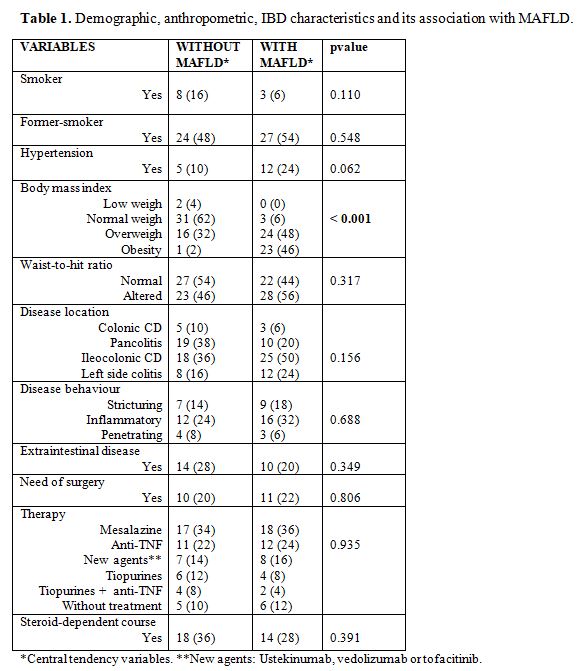P226 Nuclear magnetic resonance spectroscopy measure of protein glycosylation is a biomarker of activity and metabolic complications in Inflammatory Bowel Disease.
García Mateo, S.(1,2);Martínez-Dominguez, S.J.(1,2);Aso Gonzalvo, M.C.(1);Refaie, E.(3);Gallego Llera , B.(1);Alfambra Cabrejas , E.(1);Sanz, B.(4);Amigó Grau, N.(5);Ribalta, J.(6,7);Martínez-Micaelo, N.(8);Gargallo-Puyuelo, C.J.(1,2);Gomollón, F.(1,2,9);
(1)University Hospital Lozano Blesa, IBD Unit, Zaragoza, Spain;(2)IIS Aragón, Digestive Diseases, Zaragoza, Spain;(3)University of Milano, Medical School, Milano, Italy;(4)University Hospital Lozano Blesa, Endocrinology Unit, Zaragoza, Spain;(5)Biosfer Teslab, Chief Executive Officer, Reus, Spain;(6)University of Reus, Faculty of Medicine- Lipid and Artherosclerosis Unit, Reus, Spain;(7)CIBERDEM, Metabolic Diseases Unit, Barcelona, Spain;(8)Institut de Investigació Sanitaria Pere Virgili IISPV, Research Unit on Lipids and Atherosclerosis, Reus, Spain;(9)University of Zaragoza, Faculty of Medicine, Zaragoza, Spain;
Background
Plasma glycoproteins are acute-phase proteins, which can contribute to the development of many complex inflammatory diseases as Inflammatory Bowel Disease (IBD). Glycoprotein concentration as measured by nuclear magnetic resonance (NMR) spectroscopy has been proposed as a biomarker for monitoring activity of IBD, but has been also related to metabolic syndrome. Our goal is to further define the role of this new biomarker in IBD patients with MAFLD.
Methods
Prospective cohort study of consecutive IBD outpatients (Leonnard-Jones criteria, > 1 year) seen at reference centre, was performed from October 2020 to April 2021. Of 947 outpatients, 50 patients with IBD who met criteria for MAFLD and 50 patients with IBD and without MAFLD were matched by sex, age and IBD severity. Every IBD patient was also matched with 4 controls without IBD. Patients and controls with a previous diagnosis of CV disease, type II diabetes mellitus and under treatment for dyslipidaemia were excluded. Serum samples were analysed by NRM Spectroscopy with glycoprotein (Glyc-B, Glyc-F and Glyc-A) analysis by Biosfer Teslab, Spain. Demographic, clinical, biochemical and anthropomorphic variables were obtained prospectively in all cases. Wilcoxon Rank-sum test was used for comparison between groups with R (v 4.1.1).
Results
A total of 100 IBD patients and 400 controls were included. The median age were 51.0 (41-59) years old for each group. There were no differences in body mass index (BMI) between groups (26.4 (23.1-29.9) for IBD and 27.1 (24.4-30.4) for controls p=0.130). Regarding IBD patients, 49 (49%) had ulcerative colitis (UC) and 51(51%) Crohn’s disease (CD). Both IBD groups (with or without MAFLD) were well-matched excepting BMI as expected (table 1). Glycoprotein concentrations were significatively higher in IBD when compared to controls (table 2, p<0.001). In IBD patients with MAFLD glycoprotein concentrations were the highest (p<0.001) with no overlap with controls (table 3).
Conclusion
This prospective study confirms that glycoprotein concentrations can be a biomarker in IBD and for the first time suggests that it can be a very useful biomarker to identify MAFLD.





